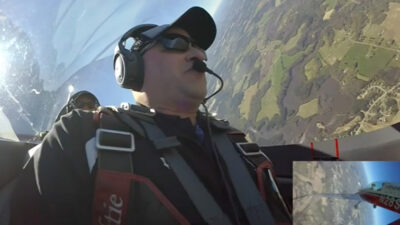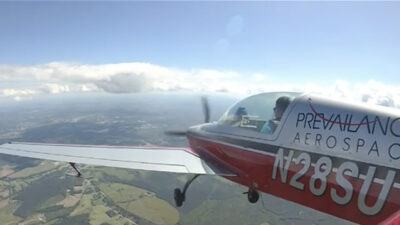Upset Training Without Getting Sick!
Both the International Air Transport Association (IATA) and the Federal Aviation Administration (FAA) recognize on-aircraft Upset Prevention and Recovery Training (UPRT) as the best method to combat the loss of control inflight (LOC-I) threat that is the leading cause of fatalities across all categories of aviation today 1&2 . On-aircraft training offers pilots the ability to experience first-hand the effects of a dynamic aircraft upset, along with the methods and procedures required to safely recover the aircraft. Only through actual exposure and training can pilots truly learn to prevent, recognize, and recover from an aircraft upset.
Most pilots need three flights to adequately adapt to and learn from dynamic upset training. Pilots often have significant apprehension before training begins, are anxious during the initial ground training phase, and experience some stress during their first flight. The training aircraft is unfamiliar, the cockpit is smaller than they are accustomed to, and many pilots are wearing a parachute for the first time. Their second flight is physically more comfortable and their anxiety is reduced, but the training scenarios are naturally stress producing. By the third flight, the pilot is familiar with their environment, and is ready for the instructor to gradually and safely increase the complexity of the training scenario. Quality upset training allows a steep learning curve.
One of the greatest deterrents to upset training, however, is airsickness. A quality training provider will ensure airsickness is not a factor. Most pilots have never experienced dynamic maneuvering, or have not been exposed to it in many years. Anxiety is also a known contributor to motion sickness, and the pilot’s initial apprehension of upset training, when combined with dynamic maneuvering, can lead to airsickness in flight 3. In fact, anxiety alone can cause motion sickness-like symptoms without flying at all 4. An airsickness event effectively stops training for multiple reasons. The pilot is no longer learning, as they are physiologically debilitated and unable to properly process information. Recovery from airsickness also takes time – not just a few minutes straight and level.
Airsickness can happen to any pilot, regardless of anxiety and stress, when the brain receives conflicting inputs 5. If your visual cues, vestibular (inner-ear) perceptions, and proprioceptive (seat of the pants) signals send different messages to the brain, you may start to feel sick. Everyone is different, but common symptoms include cold sweats, nausea, drowsiness, gastrointestinal discomfort, apathy, and/or fatigue. The symptoms themselves can range from mildly uncomfortable to completely incapacitating – however, the reduction to training effectiveness begins immediately, and gets progressively worse as the symptoms increase in severity 6.
Professional UPRT providers address airsickness concerns up front, and work diligently to minimize it while creating a training environment that maximizes the pilot’s learning. The good news is that the actual likelihood of airsickness during a professional UPRT course has proven to be very low. In fact, airsickness occurs in less than 1% of pilots who conduct upset training. Proactive training methods play a significant role in reducing the factors that are counterproductive to the pilot in training.
1. International Air Transport Association, “Loss of Control In-flight (LOC-I)”, http://www.iata.org/whatwedo/safety/Pages/loss-of-control-inflight.aspx
2. Federal Aviation Administration, 7/30/2014, “Fact Sheet – General Aviation Safety”, https://www.faa.gov/news/fact_sheets/news_story.cfm?newsId=16774
3. University of Maryland, Medical Center, 12/9/2014, “Motion Sickness”, http://umm.edu/health/medical/altmed/condition/motion-sickness
4. The Anxiety Centre, 1/10/17, “Motion Sickness, Dizzy, Lightheaded, Sick Feeling”, http://www.anxietycentre.com/anxiety/symptoms/motion-sickness-anxiety.shtml
5. American Society of Aerospace Medicine Specialists, 11/14/11, “Clinical Practice Guideline for Motion Sickness”, http://www.asams.org/guidelines/Completed/NEW%20Motion%20Sickness.htm
6. Aircraft Owners and Pilots Association, 4/1/16, “Ear, Nose, Throat, and Equilibrium Motion Sickness”, https://www.aopa.org/go-fly/medical-resources/health-conditions/ear-nose-throat-and-equilibrium/motion-sickness

Prevailance Aerospace is a UPRT provider that has been working with corporate, government, and general aviation pilots to improve safety in the aviation industry. Prevailance Aerospace uses Extra 300 Series Aircraft for training and our pilots are experienced aviation professionals from various military and general aviation backgrounds. We know that successful aviation endeavors are accomplished through an uncompromising commitment to safety, impeccable professionalism, tremendous attention to detail, and constant improvement.
http://prevailanceaerospace.com
© 2025 Prevailance Aerospace. All Rights Reserved.
Next ArticleRelated Posts

Rise Up for the Next Generation
There is no doubt in my mind that flying is the way mankind is meant to travel, yet the continued success and growth of the industry requires a refined approach to safety. As someone who flies commercially and with a new interest in a career in aviation, I want the reassurance that the pilot in command (PIC) and crew are adequately prepared if and when an aircraft ends up in an upset.

Three Considerations That Set Pilots Up for Success
Constantly reviewing aviation accidents and incidents is challenging. As an instructor, it is not only the injuries and fatalities that make it hard, but the sheer magnitude of avoidable aspects of each incident. These safety reports prove that every Pilot in Command (PIC) is accountable for what transpires.


